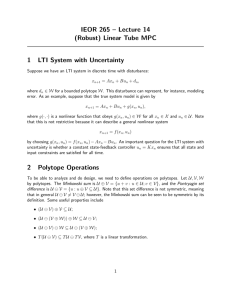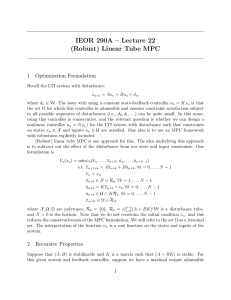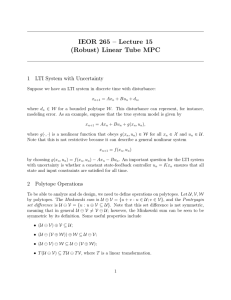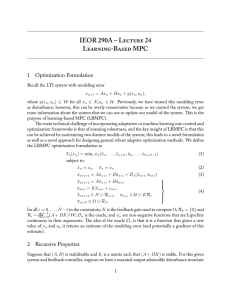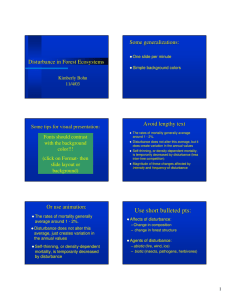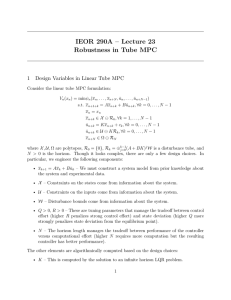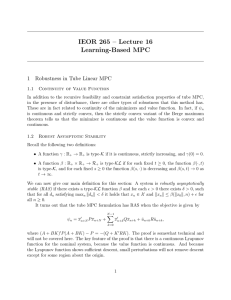IEOR 290A – Lecture 21 Robust Reachability 1 Design Variables in Linear MPC
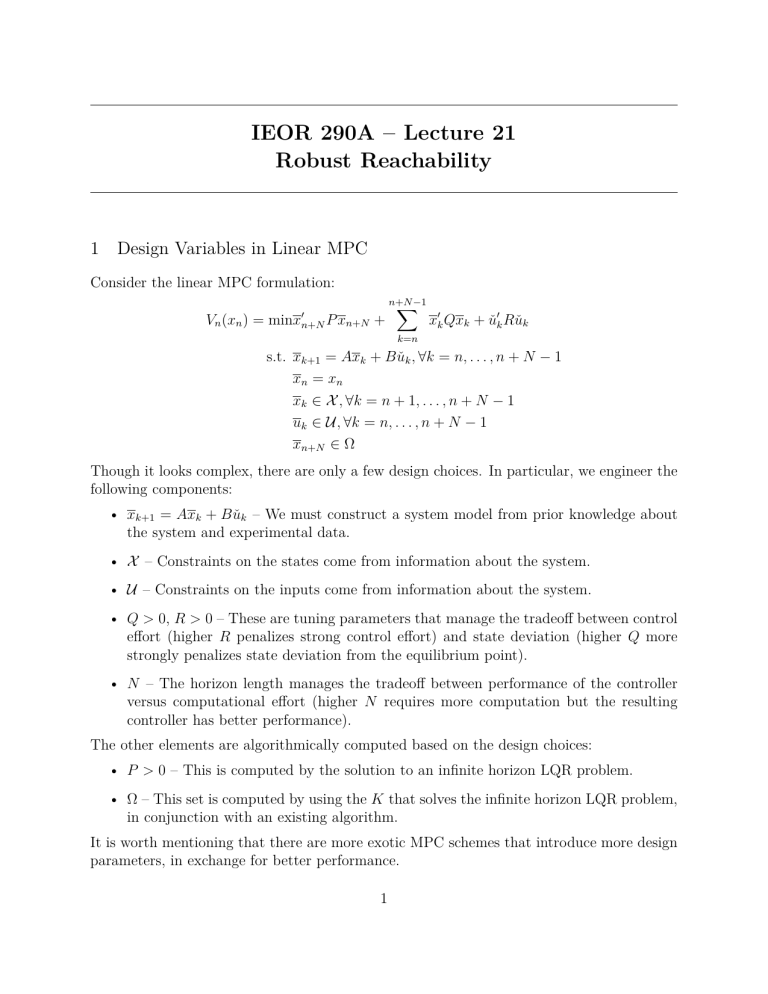
IEOR 290A – Lecture 21
Robust Reachability
1 Design Variables in Linear MPC
Consider the linear MPC formulation:
V n
( x n
) = min x
′ n + N s.t.
x k +1
P x n + N
+ n ∑ −
1 x
′ k
Qx k
′ k
R ˇ k
= Ax k k = n
+ B ˇ k
,
∀ k = n, . . . , n + N
−
1 x n
= x n x u x k k
∈ X
,
∀ k = n + 1 , . . . , n + N
−
1
∈ U
,
∀ k = n, . . . , n + N
−
1 n + N
∈
Ω
Though it looks complex, there are only a few design choices. In particular, we engineer the following components:
• x k +1
= Ax k
+ B ˇ k
– We must construct a system model from prior knowledge about the system and experimental data.
• X – Constraints on the states come from information about the system.
• U – Constraints on the inputs come from information about the system.
• Q > 0 , R > 0 – These are tuning parameters that manage the tradeoff between control effort (higher R penalizes strong control effort) and state deviation (higher Q more strongly penalizes state deviation from the equilibrium point).
• N – The horizon length manages the tradeoff between performance of the controller versus computational effort (higher N requires more computation but the resulting controller has better performance).
The other elements are algorithmically computed based on the design choices:
• P > 0 – This is computed by the solution to an infinite horizon LQR problem.
• Ω – This set is computed by using the K that solves the infinite horizon LQR problem, in conjunction with an existing algorithm.
It is worth mentioning that there are more exotic MPC schemes that introduce more design parameters, in exchange for better performance.
1
2 LTI System with Uncertainty
Suppose we have an LTI system in discrete time with disturbance: x n +1
= Ax n
+ Bu n
+ d n
, where d n
∈ W for a bounded polytope W . This disturbance can represent, for instance, modeling error. As an example, suppose that the true system model is given by x n +1
= Ax n
+ Bu n
+ g ( x n
, u n
) , where g (
·
,
·
) is a nonlinear function that obeys g ( x n
, u n
)
∈ W for all x n
∈ X and
Note that this is not restrictive because it can describe a general nonlinear system u n
∈ U .
x n +1
= f ( x n
, u n
) by choosing g ( x n
, u n
) = f ( x n
, u n
)
−
Ax n
−
Bu n
. An important question for the LTI system with uncertainty is whether a constant state-feedback controller u n
= Kx n ensures that all state and input constraints are satisfied for all time.
3 Polytope Operations
To be able to analyze and do design, we need to define operations on polytopes. Let U
,
V
,
W by polytopes. The Minkowski sum is U ⊕ V
=
{ u + v : u
∈ U
; v
∈ V} , and the Pontryagin set difference is U ⊖ V
=
{ u : u
⊕ V ⊆ U} . Note that this set difference is not symmetric, meaning that in general U ⊖ V ̸
=
V ⊖ U ; however, the Minkowski sum can be seen to be symmetric by its definition. Some useful properties include
• (
U ⊖ V
)
⊕ V ⊆ U ;
• (
U ⊖
(
V ⊕ W
))
⊕ W ⊆ U ⊖ V ;
• (
U ⊖ V
)
⊖ W ⊆ U ⊖
(
V ⊕ W
) ;
• T (
U ⊖ V
)
⊆
T
U ⊖
T
V , where T is a linear transformation.
4 Maximum Output Admissible Disturbance Invariant Set
We return to the question: Does there exist a set Ω such that if x
0
∈
Ω , then the controller u n
= Kx n ensures that both state and input constraints are satisfied for the LTI system with bounded disturbance. In mathematical terms, we would like this set Ω to achieve (a) constraint satisfaction
Ω
⊆ { x : x
∈ X
; Kx
∈ U}
, and (b) disturbance invariance
( A + BK )Ω
⊕ W ⊆
Ω .
2
It turns out that we can compute such a set under reasonable conditions on the disturbance
W and constraint sets X and U . However, there is no guarantee that this is not the null set:
It may be the case that Ω =
∅ . The algorithm for computing this set is more complicated than the situation without disturbance, and so we will not discuss it in this class.
3
